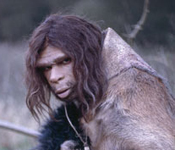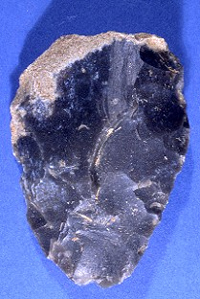|
 Uraug
(Homo sapiens neanderthalensis),
age 25, was one of eighteen in his tribe, living in what today is
central France. Uraug
(Homo sapiens neanderthalensis),
age 25, was one of eighteen in his tribe, living in what today is
central France.
It's spring in the year 81,246
bce.
Uraug was injured in a
hunting accident several months ago.
-
He sustained a fracture
of his 9th thoracic vertebra,
-
Resulting in
compression of his spinal cord.
-
He never walked
again.
-
Fortunately for
Uraug, his bowel and bladder function was not affected.
-
Revered by his tribe,
Uraug was not left to die, rather he was carried on a litter as they
migrated within their home range.
-
Now restricted to
sitting and
supine positioning, Uraug developed a
sacral decubitus.
Before his injury, Uraug was
in quite good health. Apart from several broken teeth and non-displaced fracture of his left humerus
(another hunting accident at age 18), he had come into middle age rather
uneventfully.
-
 He
is 5' 6" tall and now weighs 150 pounds, down from 160 prior to the
accident. He
is 5' 6" tall and now weighs 150 pounds, down from 160 prior to the
accident.
-
He is paraplegic, with
an infected
sacral decubitus
-
There is generalized atrophy of his leg musculature bilaterally.
-
His upper body strength
is good, which allows him to continue to make
stone tools
and help process food and animal hides.
-
Here's his
SGA form.
Wound healing greatly
increases a person's nutritional needs. |